Getting Started With Google Analytics Segments
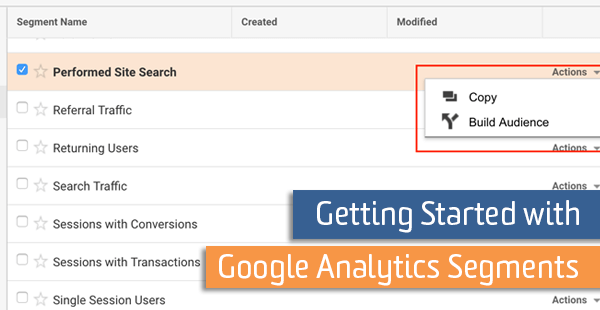
For deep investigations inside of Google Analytics, there’s no better tool in the interface than Segments – a way to dynamically categorize and compare groups of users by some shared dimensions. Whether you’ve used Segments before or are starting fresh, take some time to review the best ways to create and use Segments, the pros and cons of using Segments, and how to turn your Segments into Audiences that can be shared easily with other tools.
What Is a Segment?
Within the scope of Google Analytics, a segment is a subset of your data, or a smaller piece of the whole. Like a slice of cheese, rather than the whole wheel (easier to digest?). Segments can help us dig through all of the information in Google Analytics by creating more manageable chunks of data.
Examples of Segments:
- Users who completed a purchase
- Users who added a product to the cart, but did not make a purchase
- Sessions that included a view of a key page or type of page
- High-value users who provided their contact information in a form
Used within the Google Analytics interface, segments allow you to ‘slice and dice’ your data into smaller chunks, based on conditions that you’ve defined. Want to compare converters to non-converters and see whether they’re viewing different content throughout your site? Or isolate users who’ve visited a targeted landing page but didn’t convert? Segments are your solution.
You can also use Custom Dimensions and Custom Metrics as the basis of your segments. For example, if you’re collecting user-provided information like income or occupation (remember, no Personally-Identifiable Information), you can use that data to create unique segments, like veterinarians with an income of $200,000 or more.
Pros of Segments
- Segments can be applied to any report within the GA interface
- Segments are applied to historic data
- You can compare multiple segments in a report
- Segments do not permanently alter your data, like filters do
- You can create narrow and specific segments to isolate small subsets of data
- Segments are a personal asset in GA, so you can keep your segments to yourself or easily share segments with others
Cons of Segments
- Segments are calculated on the fly, so sampling can occur
- Segments don’t function exactly like filters (read Dorcas’ excellent post for more details on using segments vs. filters)
- Limited segments on a report – only up to 4 at a time
- Segments include users or sessions entirely within the window of the date range
- User-based segments are limited to a 90-day time frame
Creating a Segment
There are several ways to access and create segments within the Google Analytics interface, so it’s easy to jump in and get started without much configuration up front.
Predefined Segments
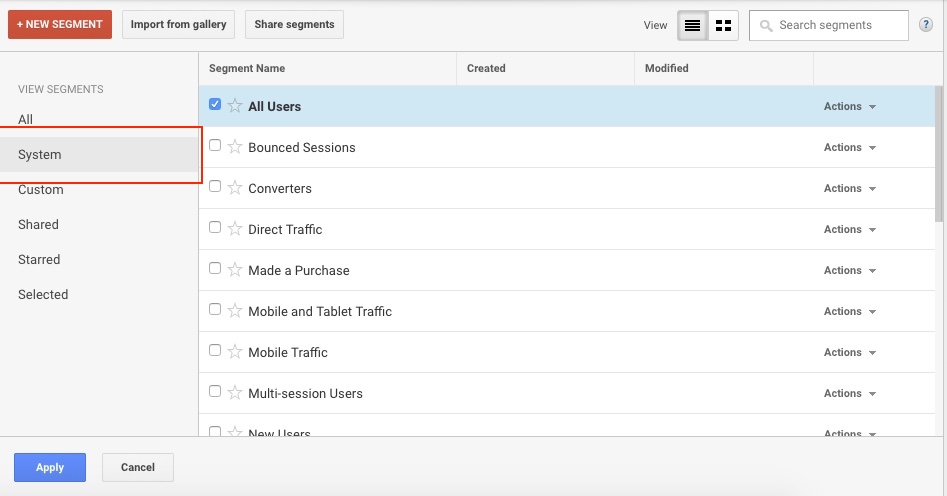
There are many predefined, or default system segments within Google Analytics, and you can start using these for analysis right away. Check the list before you start creating your own segments, just to make sure the one you need isn’t already available.
- All Users
- Bounced Sessions
- Converters
- Direct Traffic
- Made a Purchase
- Mobile and Tablet Traffic
- Mobile Traffic
- Multi-session Users
- New Users
- Non-bounce Sessions
- Non-Converters
- Organic Traffic
- Paid Traffic
- Performed Site Search
- Referral Traffic
- Returning Users
- Search Traffic
- Sessions with Conversions
- Sessions with Transactions
- Single Session Users
- Tablet and Desktop Traffic
- Tablet Traffic
Choose Your Own Conditions
Since system segments tend to be pretty generic, you’ll probably discover a lot of use cases for custom segments, which allow you to apply your own conditions and logic. You can start with the ‘greatest hits’ selection of dimension and metric filters that are built into the segments panel, but if you can’t find what you’re looking for (or want to use Custom Dimensions or Metrics), you can use Advanced options instead.
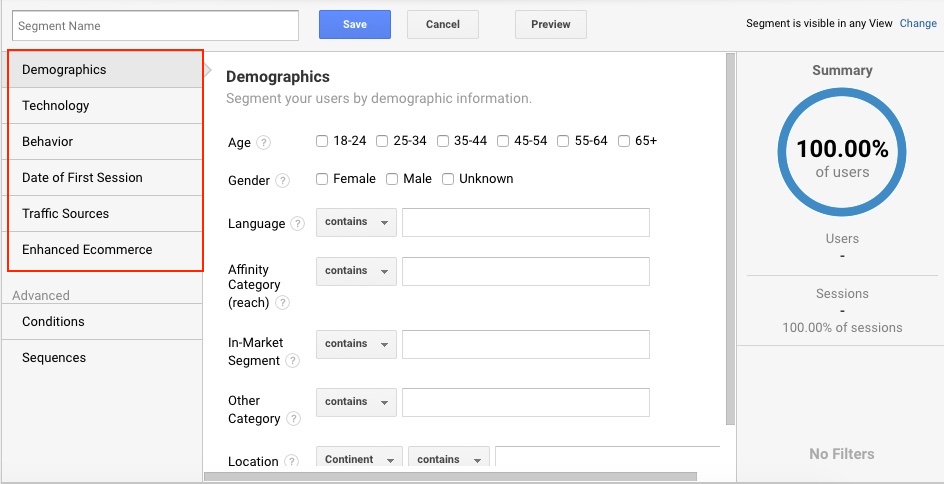
Under the Advanced section, Conditions pretty much lets you choose any dimensions and metrics to build your segment.
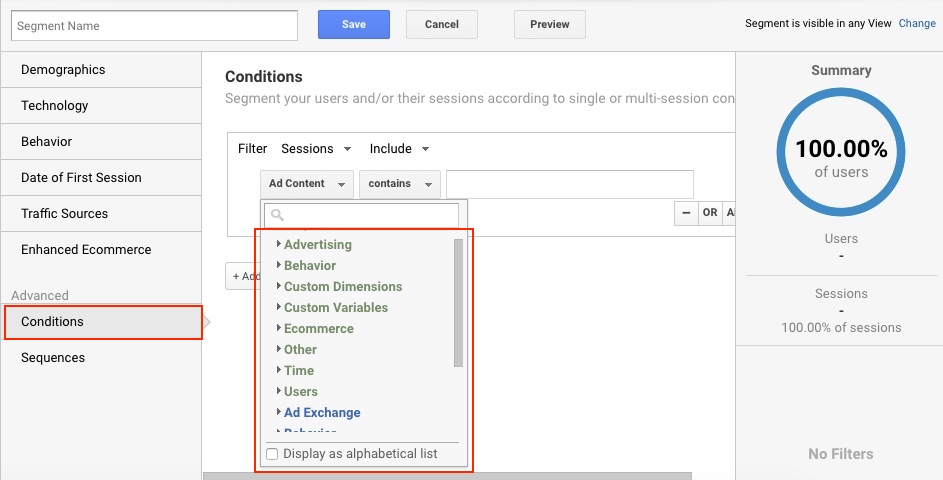
Another Advanced segment type is a sequence segment, which allows you to define sequential conditions in order to segment your users or their sessions. You can use sequence segments to analyze users who followed a certain path during their session. Maybe you want to create a segment of sessions where users landed on a specific page, viewed video content immediately after, and then ultimately made a purchase at some point in their session. Sequence segments to the rescue!
Create Segments from Custom Funnel Reports and Enhanced Ecommerce Funnel Reports
There’s another way to create segments that flies a little more under-the-radar, but it’s extremely valuable! You can actually create segments directly from within Enhanced Ecommerce shopping stage/checkout step funnel reports and (for 360 users only) Custom Funnel reports. For instance, if you want to create a segment of users who got to the billing page of the checkout process, but didn’t complete the purchase, you can easily do this with just a few clicks.
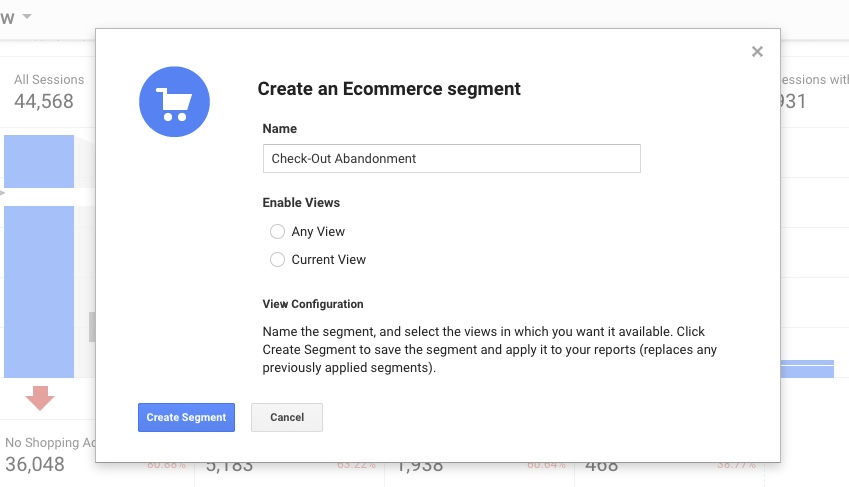
How Do We Use Segments?
We can use segments for daily reporting, ad-hoc analysis, to answer questions and investigate data issues. Segments are great for ad-hoc analysis, since they can be applied to historic data and are easily created/managed within the GA interface.
Reporting – Data Studio and Google Sheets
We can also use our GA segments for reporting with other tools, like Data Studio and Google Sheets:
Google Sheets and Google Analytics Part 2: Segments and Filters
Google Analytics Segments in Data Studio
Audiences
Finally, one of the most exciting ways segments can be used is to create audiences. Audiences can be built directly from the Admin screen in Google Analytics or even easier, can be converted from an existing Segment. You can create a segment, then build an audience based on that segment.
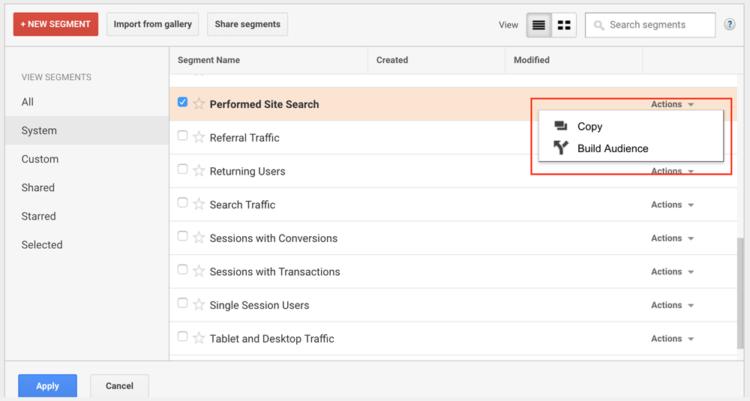
Audiences can then be shared across other products, like Google Optimize 360, Google AdWords, and DoubleClick, allowing you to target your users more successfully with marketing/advertising efforts. For a much more in-depth look at increasing revenue with strategic audiences, make sure to read Michael’s post.
You can also view your audiences in the new Google Analytics Audiences report (found within the Audience section of reports), and use them throughout Google Analytics.
With audiences, we can eliminate some of the limitations of segments:
- You get to choose how long someone stays in an audience
- Audiences eliminate the date window – as long as the person is still in the audience, you can see their historic activity
- Acts more like a user-level Custom Dimension
Once you’ve defined audiences and can analyze their performance, you can start to use that insight for action. Did certain audiences engage and convert as expected, or not? Were some audiences performing better than expected? Based on the data, you can make changes to your advertising and marketing campaigns, budgeting more for targeting high-value audiences and less for any that underperform.
Overall, segments and audiences are powerful tools that can be used in so many different ways. From analysis to action, they make our data more valuable and actionable than ever. So if you’re not using segments and audiences yet, make it a point to start soon!


